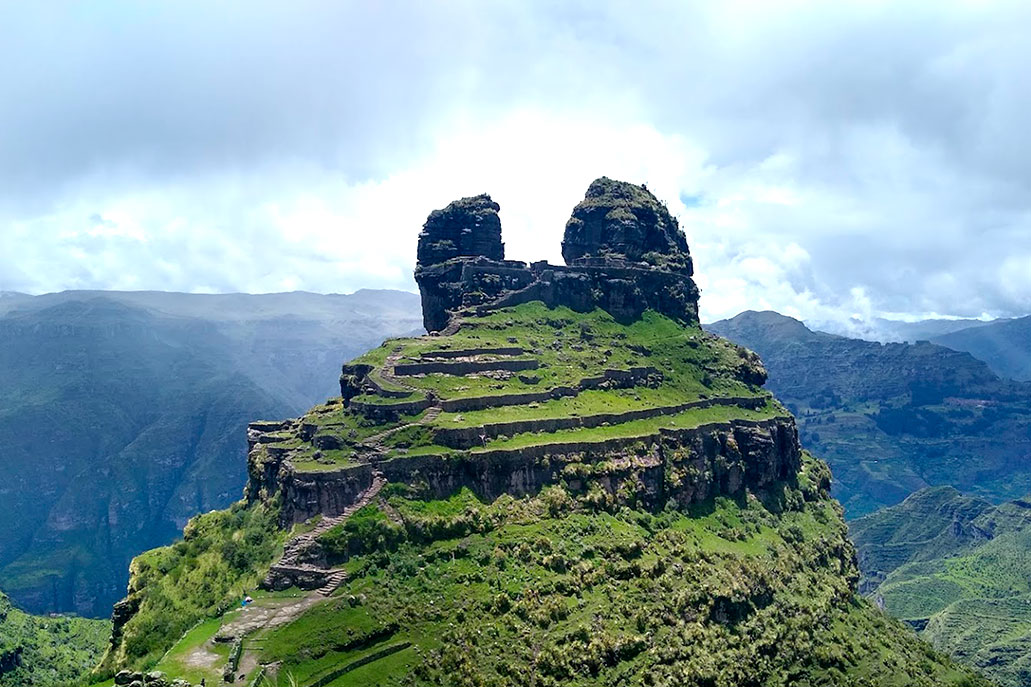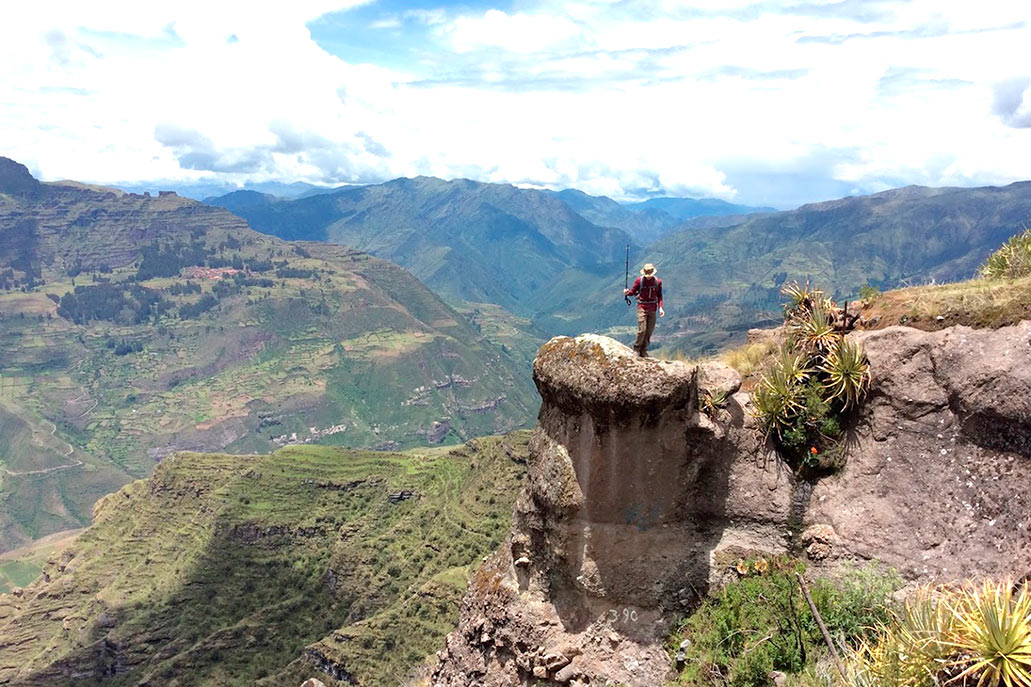Waqrapukara, an imposing ceremonial site in the south of Cusco
Waqrapukara, is south of Cusco. It was an important ceremonial center within the Inca empire. In addition to having a spectacular view of the local mountains and standing on top of one of them (in the form of horns), it is a space with a lot of history. Conceived as a temple and a fortress, Waqrapukara is a sanctuary of approximately 4.5 hectares in size. It has to be a mandatory destination for all those who visit Cusco.
Content
- 1. Waqrapukara imposing sanctuary
- 2. Notes on Waqrapukara
- 3. The best routes from Cusco to Waqrapukara
- 4. Recommendations
- 5. Frequently asked questions
- a) What is Waqrapukara?
- b) Where is it located?
- c) What is Waqrapukara’s altitude?
- d) What is the climate like?
- e) When to go?
- f) How to go?
- g) How much does it cost to go to Waqrapukara?
- h) What is there?
- i) Can you go to Waqrapukara without a tourist agency?
- j) How much is the entrance fee to Waqrapukara?
- k) Is it easy to get there?
1. Waqrapukara imposing sanctuary
Waqrapukara, proves to be an important Inca sanctuary. The evidence left by its ruins shows an important and exclusive architecture, dedicated to political and religious centers. It is located at 4,300 meters above sea level, and currently belongs to the Huayki community.
The location is completely natural, like most Inca constructions, which respect nature and at the same time take advantage of its topographical formations to enhance its fortresses and sanctuaries. For example, Waqrapukara, is built on a peak, taking advantage of the natural rock formation, which resembles two horns.
Something important to note is that some residents consider calling it “Llamapukara” replacing the horns “Waqra” with the word “Llama”. Thus giving it a more natural name in accordance with the Quechua language. In this way, the image shown by the two rock formations would be the ears of the animal, which is attentive to the arrival of foreigners.
From this place, it is possible to appreciate the long mountain ranges in addition to seeing the Apurímac riverbed, where the last Inca bridge is also located, we are talking about the Q’eswachaka bridge .
Some of its enclosures show special constructions and only located in centers of great political and religious importance. Exterior niches with triple jambs are very rare throughout the Tawantinsuyo, these formations were only found in places of great prestige. They were found only in two other places in Maukallaqta and Pachacamac. These two examples demonstrate the importance of the sacred in relation to the Andean worldview, they are also places where creation myths or important characters in Andean mythology are recounted.
Waqrapukara was originally inhabited by the Canchis or Qanchi tribe. It was used as an observatory and also as a dwelling for the family and the curaca leader of the tribe. It is also believed that it was a Pacarina, hence the presence of some fine finishes.
2. Notes on Waqrapukara
Waqrapukara, was a fortress during its foundations and witnessed some battles. It is estimated that, in the first instance, the Canchis built the foundations and roads to this fortress. After joining the Canchis to the Incas to fight, joining forces, against the Chancas; the fortress became a sacred complex where many religious acts were probably performed to the gods.
Some legends attributed to this place refer to an attempted uprising. It is said that while the Inca Huayna Capac was ruling, one of his generals, after gathering an immense army, rebelled against the empire. This man was called T’ito Qosñipa, this character was cornered by the Inca army inside Waqrapukara. Due to the difficulty of crossing the natural barricade, the commander of the Tawantinsuyo army decided to cut off the water supply. T’ito Qosñipa surrendered shortly after, as punishment they cut off one of his ears and he was pardoned for being a great general. He then continued to win battles for the Inca.
This shrine is divided into two sections. One high and one low. In the upper zone there are representations and constructions that define it as a sacred place. You can also find some passages, portals with a double jamb and niches of a ceremonial nature. In this area you can see how the two rock shapes that have the shape of horns were naturally integrated.
The lower area is comprised of eight platforms, approximately 153 meters long and 1.80 meters high. As is well known, these terraces are adequately complemented by the topography of the place. Other enclosures can be found very close to this area, these enclosures also fulfilled a ceremonial function.
In 2017 it was recognized as Cultural Heritage of the Nation, under resolution No. 128 – 2017 of the Vice Ministry of Cultural Heritage of the Ministry of Culture. Publishing on July 19.
In 2017 it was recognized as Cultural Heritage of the Nation, under Resolution No. 128 – 2017 of the Vice Ministry of Cultural Heritage of the Ministry of Culture. It was published on July 19.
3. The best routes from Cusco to Waqrapukara
When you decide to go to this destination on your own, there are three possible routes to follow, let’s see:
- a) Route 1
- You can go to that destination with a bus trip to the district of Acomayo.
- Once in Acomayo, follow the Huáscar branch that leads to the Huayqui community. It is a trail path, ideal for hiking. It’s 7.5 kilometers.
- Once in the community of Huayki, walk towards Waqrapukara, for about three more hours.
- b) Route 2
- From Cusco you reach Acomayo and take a car in the direction of Sangarará.
- From Sangarará, take a detour towards Punta Carretera. From this point starts the walk towards Waqrapukara.
- The walk is 8 kilometers. The walk lasts approximately three hours.
- c) Route 3
- From Cusco you will have to get to Acomayo.
- In Acomayo, take a taxi or public transportation to Pomacanchi. From this point, follow the path until you reach Santa Lucia.
- From Santa Lucia, follow the road to Waqrapukara for two hours of walking.
Despite these possibilities, the safest way to get there is through a tourism agency. The agency will be responsible for providing timely information, food, transportation and first aid in the event of any mishap or inconvenience.
The tours offered by tourist agencies have two main options: the one-day tour and the two-day tour.
- The one-day tour will include transportation, food, a complete guide to the place and nearby areas, and some tools for the walk. The costs of this tour usually vary between 60 and 80 US dollars.
- The two-day tour includes everything mentioned in the one-day tour. In addition, a camp is prepared next to Waqrapukara. As for the prices, they range from 140 to 200 US dollars.
4. Recommendations
- Wear hiking shoes
- Light clothing for long walks, it is also preferable to wear a windbreaker jacket.
- Waterproof poncho in case it rains.
- Hat and sunscreen.
- Water and if you want some candy.
- Chocolate bars and nuts.
- Altitude sickness pills and coca leaves.
- Have regular training before the walk. (Not necessary)
5. Frequently asked questions
a) What is Waqrapukara?
Waqrapukara is a sanctuary and possibly a fortress, due to its location and accessibility. It was very important during the expansion of the Inca empire because it was a ceremonial and religious place.
b) Where is it located?
The Waqrapukara sanctuary is located in the province of Acomayo in the Cusco Region. Exactly in the district of Acos and in the community of Huayqui
c) What is Waqrapukara’s altitude?
Waqrapukara is at an altitude of 4300 meters above sea level.
d) What is the climate like?
The climate in Waqrapukara is cold and dry. However, in the mornings it can reach temperatures close to 23°C. or 73°F. Keep in mind that the months with less rain are May to October.
e) When to go?
You can go any day of the year. However, it is recommended to do it during the months with less rain: May to October.
f) How to go?
You can go independently and through a tourism agency. There are two types of tours.
g) How much does it cost to go to Waqrapukara?
Through a tourism agency on the one-day tour prices vary from 60 to 80 US dollars per person. While the two-day tour costs US$150 to US$200.
h) What is there?
The Waqrapukara sanctuary has an area of 4.5 hectares. In addition to remains of terraces and some ceremonial constructions. In addition, you can see the imposing mountain in the form of horns.
i) Can you go to Waqrapukara without a tourist agency?
Yes, it is possible to do it on your own. However, you have to take into account the transportation, food or equipment needed if you want to spend the night in the place.
j) How much is the entrance fee to Waqrapukara?
The entrance to Waqrapukara is free, it costs 10 soles (3 US dollars).
k) Is it easy to get there?
It is a short route and does not have many complications. The shortest route is two hours.
By Imachupicchu – Last updated, August 22, 2024


